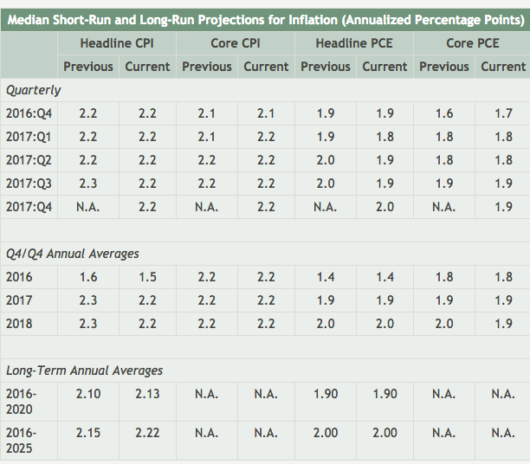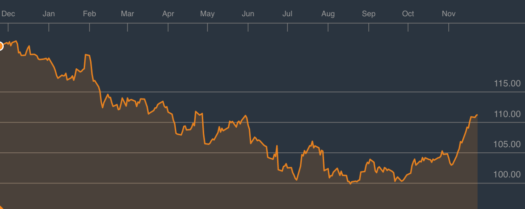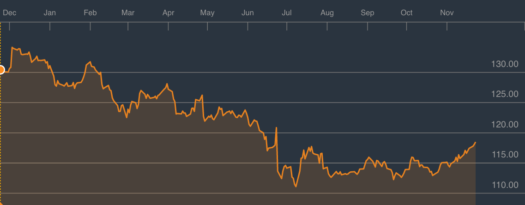In Washington DC, all the best and the brightest in both parties are horrified by the prospects of a Trump Presidency. But perhaps we owe Trump an apology, as in some respects he already controls our trade policy. Here’s a report from 4 months ago:
The U.S. government is sending a message to countries it believes are manipulating their currencies: We’re watching you.
A Treasury report
targets five countries in particular: China, Japan, Korea, Taiwan and Germany. Each meets at least two of the three criteria that “determine whether an economy may be pursuing foreign exchange policies that could give it an unfair competitive advantage against the United States.”
At a time when currency devaluation has become a major tool used by multiple countries to stimulate growth, the U.S. is looking to protect its own interests. The report is an outgrowth of the Trade Facilitation and Trade Enforcement Act of 2015, a bipartisan effort aimed at stemming the global race to the bottom.
The criteria to determine whether a country should be on the “Monitoring List” of countries using unfair currency practices are: a trade surplus of larger than $20 billion, or 0.1 percent of U.S. GDP; a trade surplus with the U.S. that is more than 3 percent of that country’s GDP; “persistent one-sided intervention,” defined as purchases of foreign currency amounting to more than 2 percent of the country’s GDP in a one-year period.
No country meets all three criteria, according to the report, though the five on the list meet at least two.
For those not familiar with open economy macroeconomics, those criteria reach almost Trumpian levels of ignorance. Where to begin:
1. If you worry about this sort of thing (and a few respectable economists do) then you would look at a completely different set of criteria. For instance, the trade deficit is a meaningless data point, if anything, you’d look at current account deficits.
2. Bilateral deficits with the US are stupidity squared, a data point of no conceivable relevance, even to the most mercantilist economist on Earth. All that “matters” is overall surpluses or deficits, not bilateral.
3. If you are looking for “villains”, you would certainly not look at overall surpluses; rather you’d focus on surpluses as a share of GDP, or some similar metric. Otherwise you’d be biased against large countries. The current account surplus for China is about $170 per capita, for Switzerland it’s over $8000 per capita. Even as a share of GDP the Swiss surplus is far higher.
4. “Intervention” should not be defined as purchases of foreign assets, but rather as high government saving rates. All government saving tends to have the same effect on the CA balance, whether it is used to buy domestic or foreign assets.
5. The Treasury singles out Asian countries in a Trumpian fashion, for no apparent reason. Switzerland has a $71 billion CA surplus, and engages in massive purchases of foreign assets to hold down the value of the SF. There’s two criteria right there. Why did it not make the list? I have no idea, its trade surplus is also well above $20 billion. Lots of other northern European countries also have massive CA surpluses, and spend lots of money holding down the value of their currencies. In contrast, China’s recently been trying to hold up the value of its currency.
6. If you were an American mercantilist, I’d think that you’d be much more worried about Germany’s $300 billion CA surplus, than China’s $250 billion CA surplus. Germany exports lots of capital goods that might otherwise be bought from America, whereas China tends to export less sophisticated goods, which might otherwise be produced in other Asian countries, or Mexico. Norway, Sweden, the Netherlands and even Italy have CA surpluses far in excess of $20 billion. Notice that the Treasury follows in the proud tradition Pat Buchanan and Donald Trump in pointing fingers mostly at Asian countries, even though the logic of their mercantilist argument would suggest we should target the northwest Europeans. Perhaps Germany was put on the list to try to make the racism appear a bit less blatant.
PS. I forgot to shed a few tears for the “victims” of all this evil currency manipulation. There’s Australia, with its $62 billion deficit, and no recessions in 25 years. The UK, with its $162 billion deficit and the US, with its $473 billion deficit. Both countries have a 4.9% unemployment rate. In contrast, those sneaky eurozone members with their $394 billion CA surplus keep stealing our jobs, which probably explains their 10.1% unemployment rate.
PPS. I don’t put all this on the Treasury; it’s Congress that forces them to engage in this sort of nonsense.
PPPS. Speaking of Trump, last May I had commenters earnestly informing me that I should support Trump because he favored low interest rates. Now Trump is slamming Yellen for her low interest rate policy. Trump reminds me of that anecdote about 100 monkeys typing away. Yes, there’s a tiny chance they might randomly type out Hamlet, but I’d put my money on something far worse. There are many more ways to screw up than there are ways to succeed.
And no, this is not “normal” in politics. Normal politicians lie and change their views on occasion. Hillary’s not much worse than average (although she is certainly worse.) But Trump’s just completely off the charts in terms of policy ignorance and personal dishonesty. I’ve never seen anything close to this in my life, and I’ve been following politics since the late 1960s. Nixon might have been closest on the honesty criterion, but of course was far more knowledgeable. And even Nixon tried to avoid statements that were obvious lies. He was a devious liar. Trump just doesn’t care. He’ll look you in the eye and tell you that he opposed the Iraq War. And the reporter who asked the question will be too cowardly to call him a liar to his face. I almost hope Trump wins. We deserve him.
I said “almost”, I’m not quite there yet. 🙂




